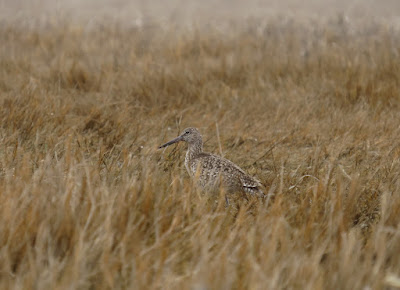Five minutes upriver, I pass under a railroad bridge. At this point, the nearest road veers away taking with it any vehicle noise. Fifteen minutes upriver, I pass three or four houses, built on what little high non-state land there is in this section of the Pawtucket. The river immediately turns sharply north, and I pass by a beaver lodge that still has a good stash of winter food in front of it. For the next hour, there are no signs of people other than a couple trails that come from who knows where.
It is a fine day - all sun with temperature heading from an overnight 39F to about 60F. There is some wind out of the south, but it doesn't reach the river in any steady fashion. The water is high, maybe two feet above normal and there is some current to work against. Much of the Pawtucket passes through the Great Swamp, and although different parts of the swamp currently have different names, I'll bet that originally, it was all known as the "Great Swamp".
 |
Beaver Lodge on the right, food stash in center
|
The river is bounded by lowland forest, swamp (wetlands with trees), and a bit of higher land, which is probably ancient seashore sand dunes. Most of the trees are hardwoods, except for the sandy areas, where groves of sugar pines dominate. Sugar pines do well in sandy soil. Thick brush lines the river almost everywhere. With the water high, the swamps are flooded with a few inches of water. In these conditions, I'm not expecting to see too many large birds. Great Blue Herons for example, will be back away from the rive in the flooded puddles fishing for frogs and other little critters. I do spot a couple Herons, and that is just what they were doing. Big birds aside, there is a nonstop chorus of mostly unseen songbirds.
 |
Note the gnawed tree. The brush pile next to it covers the vent hold of a beaver's bank burrow
|
With the current, I suspected that I might not be able to reach the Burdickville portage. Burdickville has a few houses, a road bridge crossing the river, and the remains of an old mill. In this case, the remains are a broken dam, a mill race, and a cast iron turbine that sits at the head of the race. However, the extra flow has created some long eddies which make it easier than usual to get up to the portage, which is in the bottom of the mill race. It's a very short portage - maybe 20 feet, but it is awkward climbing out of the channel with a canoe.
From here on up, the river will gradually narrow, and the current will gradually increase. I plan to turn at the confluence of the Wood River, but I can't remember how far that is. Just as the current really becomes onerous, I spot familiar terrain marking the entrance of the Wood River. I know well enough that the going will only get tougher beyond this, so I turn back after a short break.

All along I've been thinking about the contrast between my last trip, on the upper Housatonic, and this one. Through a camera's eye, the two rivers might not appear to be significantly different. That section of the Housatonic was new terrain to me, yet I found it predictable and rather boring. Here, I'm on water that is familiar, yet it never seems predictable. Up close, there are differences, of course. The Housatonic passed through forests and old pasture lands. The Pawcatuck is immersed in a great swamp with limited building sites and no real farmland. Emotionally, this river is one where anything can happen while that river had had its mystery removed. Here there is the possibility of being surprised or being awed, there is always a reason to keep going. This is the type of land where our greatest legends and fairy tales come from. This is the land of not knowing.
The current whips me along and Burdickville shows up in short order. I portage the dam. It is runnable at this flow, but not a good idea when paddling alone. It is an easy quick trip out.


















































